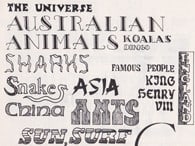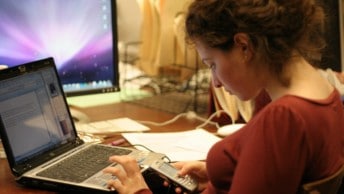A few times a year my family and I make an interstate trip to visit my parents.
One of the activities in which I take much delight during these visits (aside from my mother’s cooking and seeing my parents dote on their grandchildren) is rifling through the old boxes that I never got around to taking with me when I first moved out of home years ago.
It was during one of these recent trips that I stumbled upon a gem of a book from my childhood: The Lettering Book, by Noelene Morris.

As I flicked through it, I realised that this dog-eared children’s masterpiece was almost entirely responsible for igniting my interest in design and typography. While Bringhurst and other typography texts have their place on my bookshelf today, this practical, fun approach to typography is a fantastic way to get kids excited about typefaces and applying care to letterforms. I can remember spending hours copying many of the typefaces by hand, and inventing my own letterforms that had variety, personality and type empathy.

First published in 1982 in a spiral-bound cover, and republished as recently as 2006, there are still copies available online.
There are good reasons for its longevity. The Lettering Book is more than just “typography for kids.” As well as the basics of typography—serif, sans serif, slab serif, decorative, and other type families—there are pages dedicated to page layout, connectors, containers, alignment and more. Given the number of time it was reprinted, I’d wager this book is responsible for an entire generation of kids excited about typography and design.
And what a perfect primer for sketchnoting! I’ve always enjoyed experimenting with different graphic elements on a page, but this is probably where much of my inspiration first came from.




For fear of sounding old, I wonder if today’s kids share the joy of creating their own typefaces on the headings of their school pages … I suspect not. You don’t learn the intricacies of creating letter shapes by typing an assignment up on the computer and choosing a single dropdown from Microsoft Word!
I grabbed the book from my parents’ bookshelf to bring home to Melbourne, hoping it might instil in my daughters the same sense of appreciation for design and type. And if it doesn’t, I’m sure it will still serve as a valuable reference (perhaps when preparing for one of the workshops that I’m teaching soon!)
Did you grow up copying typefaces from The Lettering Book? I’d love to hear from you!






OMG Matt, I had that book.. somewhere over time I have lost it. I remember it being one of the inspirational sources for my love of typefaces, thanks for bringing back the memories.
My pleasure, Gary. I’ve given it to my eldest daughter and I can see her starting to incorporate some “fanciness” into some of her lettering. It begins! :)
Awesome! I know I still got this book laying around somewhere.
Yeah, break it out. It’s full of gold!
Yes indeed… A refreshing and gentle side of type. Im ordering it today.
Thanks Matt.
You will love it! :)
OMG Matt, I also had that book and loved it! I used to use tracing paper to trace over the letters and it taught me about different styles, spurs and axes. I totally don’t have it anymore, shame, please post more pics.
You can still find it online for $10-$15. Grab yourself a copy for nostalgia’s sake!
Haha – we all had shared childhoods! I used to use The Lettering Book along with The Drawing Book (http://amzn.to/Yon6l7) – same size/format, with a similar spiral binding, both published by Scholastic – I treated them like they were a pair! Still got them both, sans covers that got worn off and lost during some happy, lazy Saturday afternoons. =)
The Drawing Book! Brilliant! I never had the pleasure as a child, but just ordered myself a copy. Cheers :D
I also had a similar book way back in the 70’s. I used to love coming up with psychedelic looking typefaces using my derwents. Almost became an apprentice signwriter, but ended up as a trainee draftsman. Layout & draftsmanship was taught with a fanatic zeal by old school senior draftsmen (no females). It took six months of tuition in how to prepare a pencil: using emery paper to create a chisel edge or fine point; when to use a 4H or 2B lead; keeping your wrist off the board so that you don’t smudge your work and the use of cuff covers so you could get several days from one shirt! Finally you could graduate to ink using an adjustable nib to create various line widths after loading the nib from a bottle. Got my first set of Rotrings after about two years. They cost me about a weeks wages! Not many people have a “hand” anymore and I must admit mine has suffered from fifteen years of CAD. But it all comes back when filling out forms and still gets commented on. Good to see people still appreciating it and still using it to get a message across (albeit on digital media).
I’m know I still have this in a box in my basement and I’ve been searching all week. I loved this book as a kid and used it many times for my fancy report covers and title pages. I’m still into graphic design and this book was what first inspired me!!